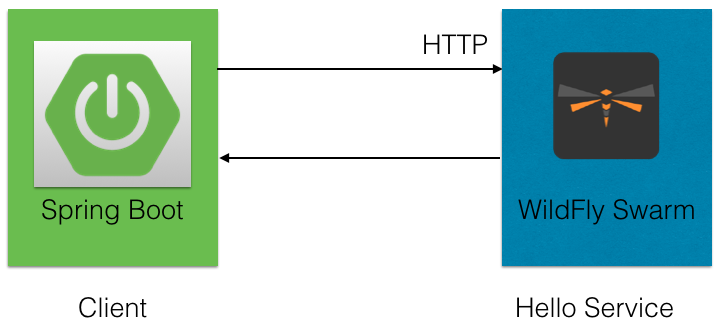Two microservices using Spring Boot and WildFly Swarm with Apache Camel running in MiniShift
There are three Maven projects:
- client - Spring Boot application with Camel that triggers every 2nd second to call the hello service and log the response. The client uses Camel client side retry for error handling.
- client-hystrix - A client that uses Hystrix as circuit breaker for error handling.
- helloswarm - WildFly Swarm application hostin a hello service which returns a reply message.
The diagram below illustrates this:
The applications can be deployed in a OpenShift cluster. You can run a OpenShift cluster locally using MiniShift which you can find more details here: MiniShift
This source code is used for a talk at various conferences, and you can find the slides for the talks in the slides directory.
I gave a talk Developing cloud-ready Camel microservices at Red Hat Summit 2017 which was video recorded and posted on youtube
When using Maven tooling you want to setup your command shell for docker/kubernetes which can be done by
minishift docker-env
Which tells you how to setup using eval
eval $(minishift docker-env)
You can deploy the WildFly Swarm application which hosts the hello service.
cd helloswarm
mvn install
If the build is success you can deploy to kubernetes using:
mvn fabric8:deploy
You can deploy the Spring Boot application which is the client calling the hello service
cd client
mvn install
If the build is success you can deploy to kubernetes using:
mvn fabric8:deploy
You should then be able to show the logs of the client, by running oc get pods and find the name of the pod that runs the client, and then use oc logs -f pod-name to follow the logs.
However you can also run the application from the shell and have logs automatic tailed using
mvn fabric8:run
And then when you press cltr + c then the application is undeployed. This allows to quickly run an application and stop it easily as if you are using mvn spring-boot:run or mvn wildfly-swarm:run etc.
The client-hystrix application which uses Hystrix can be viewed from the Hystrix Dashboard.
To install the dashboard you first need to install a hystrix stat collector which is called Turbine:
oc create -f http://repo1.maven.org/maven2/io/fabric8/kubeflix/turbine-server/1.0.28/turbine-server-1.0.28-openshift.yml
oc policy add-role-to-user admin system:serviceaccount:myproject:turbine
oc expose service turbine-server
Notice that the project name used for adding the policy is mypolicy, if you use a different project name, the adjust accordingly.
Then you can install the Hystrix Dashboard:
oc create -f http://repo1.maven.org/maven2/io/fabric8/kubeflix/hystrix-dashboard/1.0.28/hystrix-dashboard-1.0.28-openshift.yml
oc expose service hystrix-dashboard --port=8080
You should then be able to open the Hystrix Dashboard if you go into the OpenShift web console and click the url link of the deployment, something like (http://hystrix-dashboard-myproject.192.168.64.3.nip.io/)
Credits to Charles Moulliard for instructions: https://github.com/redhat-microservices/lab_springboot-openshift/#5-enable-circuit-breaker
The client-hystrix application which uses Hystrix can be viewed from the Hystrix Dashboard.
To install the dashboard you first need to install a hystrix stat collector which is called Turbine:
kubectl create -f http://repo1.maven.org/maven2/io/fabric8/kubeflix/turbine-server/1.0.28/turbine-server-1.0.28-kubernetes.yml
Then you can install the Hystrix Dashboard:
kubectl create -f http://repo1.maven.org/maven2/io/fabric8/kubeflix/hystrix-dashboard/1.0.28/hystrix-dashboard-1.0.28-kubernetes.yml
You should then be able to open the Hystrix Dashboard via
minikube service hystrix-dashboard

